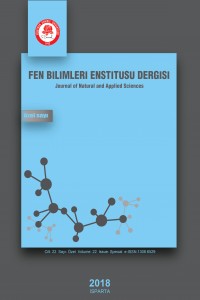Öz
Antioxidants are compounds that neutralize and inactivate free radicals which are the main cause of diseases and aging in the bodies. There are a number of factors that influence the yield of extraction of these molecules. The purpose of this study was to optimize the ultrasonic extraction of polyphenols from Cinnamonum zeylaniccum and Rhus coriaria by response surface methodology. Experiments were performed using sweep mode ultrasound waves and methanol as solvent. The parameters were solid-per-liquid ratio, extraction temperature and duration. As a result of the statistical analysis done by Design Expert software, the function which expresses the effect of the parameters on the quantity to be obtained in industrial polyphenol production was found as a quadratic model. The optimum conditions were determined as 30°C for temperature, 100 g of plant /50 ml methanol for solid-to-liquid ratio, and 15 minutes for extraction time. At the optimum conditions, cinnamon's ultrasonic extraction on "sweep" mode produced 2726.4 mg/100 g of plant gallic acid equivalent of polyphenols, whereas sumac produced 1211 mg/100 g of plant polyphenols at the same conditions, except the temperature of 50°C.
Anahtar Kelimeler
Gallic acid Extraction; Cinnamonum zeylaniccum; Rhus coriaria; Optimization
Kaynakça
- [1] Baublis, A. J., Clydesdale, F. M., Decker, E. A. 2000. Antioxidants in wheat-based breakfast cereals. Cereal Foods World. 45,71-74.
- [2] Sivritepe, N. 2000. Asma, üzüm ve şaraptaki antioksidantlar. Gıda. Dünya Yayınları, 12,73-78.
- [3] Canivenc-Lavier, M. C., Vernevaut, M. F., Totis, M., Siess, M. H., Magdalou, J., Suschetet, M. 1996. Comparative effects of flavonoids and model inducers on drug-metabolizing enzymes in rat liver. Toxicology, 114(1), 19-27.
- [4] Moon, Y. J., Wang, X., Morris, M. E. 2006. Dietary flavonoids: effects on xenobiotic and carcinogen metabolism. Toxicology in vitro, 20(2), 187-210.
- [5] Yıldırım, M. E., Canbal, M., Ozyuvali, E., Karataş, Ö. F. 2016. Urological recommendations of Hadji Pasha’s, a Turkish aged doctor in Anatolia. Avicenna journal of phytomedicine, 6(5), 502.
- [6] Morshedloo, M. R., Maggi, F., Neko, H. T., Aghdam, M. S. 2018. Sumac (Rhus coriaria L.) fruit: Essential oil variability in Iranian populations. Industrial Crops and Products, 111, 1-7.
- [7] Moure, A., Cruz, J. M., Franco, D., Domı́nguez, J. M., Sineiro, J., Domı́nguez, H., Núñez, M. J., Parajó, J. C. 2001. Natural antioxidants from residual sources. Food chemistry, 72(2), 145-171.
- [8] Turkyilmaz, H., Kartal, T., Yildiz, S. Y. 2014. Optimization of lead adsorption of mordenite by response surface methodology: characterization and modification. Journal of Environmental Health Science and Engineering, 12(1), 5.
- [9] Goktas, F. M., Sahin, B., Yigitarslan, S. 2015. Production of sterilizing agents from Calendula officinalis extracts optimized by response surface methodology. International journal of analytical chemistry.
- [10] Dashtianeh, M., Vatanara, A., Fatemi, S., Sefidkon, F. 2013. Optimization of supercritical extraction of Pimpinella affinis Ledeb. using response surface methodology. Journal of CO2 Utilization, 3, 1-6.
- [11] Levin, L., Herrmann, C., Papinutti, V. L. 2008. Optimization of lignocellulolytic enzyme production by the white-rot fungus Trametes trogii in solid-state fermentation using response surface methodology. Biochemical Engineering Journal, 39(1), 207-214.
- [12] Balcı, S. Yıgıtarslan, S. 2017. Optimization of ultrasonic extraction of total flavonoids from Cinnamonum zeylaniccum. International Journal of Secondary Metabolite. 4(3). 108-116.
- [13] Ozturk, B, Yigitarslan S. 2017. Microwave extraction of gallic acid equivalent of total flavonoids from Nigella Sativa. International Journal of Secondary Metabolite. 4(3). 117-124.
Ayrıntılar
| Bölüm | Makaleler |
|---|---|
| Yazarlar | |
| Yayımlanma Tarihi | 5 Ekim 2018 |
| Yayımlandığı Sayı | Yıl 2018 Cilt: 22 Sayı: Özel |
Kaynak Göster
e-ISSN :1308-6529
Linking ISSN (ISSN-L): 1300-7688
Dergide yayımlanan tüm makalelere ücretiz olarak erişilebilinir ve Creative Commons CC BY-NC Atıf-GayriTicari lisansı ile açık erişime sunulur. Tüm yazarlar ve diğer dergi kullanıcıları bu durumu kabul etmiş sayılırlar. CC BY-NC lisansı hakkında detaylı bilgiye erişmek için tıklayınız.


